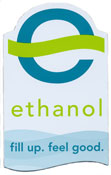 According to Paddock Talk, the CEOs of General Motors, Ford and DaimlerChrysler are supporting efforts that seek to provide 25 percent of America’s energy needs from renewable sources by 2025, known as 25X’25. In meetings with Congressional leaders today, Chrysler Group President and CEO Tom LaSorda, Ford Motor Company Chairman and CEO Bill Ford and General Motors Chairman and CEO Rick Wagoner gave their support the initiative, which is an effort led by the Energy Future Coalition and supported by agriculture and forestry groups to get 25 percent of the nation’s transportation energy needs met by renewable fuels by 2025.
According to Paddock Talk, the CEOs of General Motors, Ford and DaimlerChrysler are supporting efforts that seek to provide 25 percent of America’s energy needs from renewable sources by 2025, known as 25X’25. In meetings with Congressional leaders today, Chrysler Group President and CEO Tom LaSorda, Ford Motor Company Chairman and CEO Bill Ford and General Motors Chairman and CEO Rick Wagoner gave their support the initiative, which is an effort led by the Energy Future Coalition and supported by agriculture and forestry groups to get 25 percent of the nation’s transportation energy needs met by renewable fuels by 2025.
100 Illinois Ethanol Pumps
 Illinois Corn Growers are proud to announced the grand opening of the state’s 100th E85 fuel station Wednesday in Litchfield. According to ICGA, Gov. Blagojevich contributed $40,000 in state funding to establish the new E-85 facilities in Litchfield, and he is also investing $25 million to support research, production and consumption of ethanol in Illinois as part of the state budget that was recently approved.
Illinois Corn Growers are proud to announced the grand opening of the state’s 100th E85 fuel station Wednesday in Litchfield. According to ICGA, Gov. Blagojevich contributed $40,000 in state funding to establish the new E-85 facilities in Litchfield, and he is also investing $25 million to support research, production and consumption of ethanol in Illinois as part of the state budget that was recently approved.
Badger State Ethanol
 Here’s a nice shot of the Badger State Ethanol plant in Monroe, Wisconsin – sent in by reader Gary Dikkers, who took it “on a very cold day in February.” The plant started production mid-October, 2002 with a name-plate capacity of 40 million gallons of ethanol and 128,000 tons of dried distillers grains with solubles (DDGS) each year. Since startup, the plant has continued to increase production up in excess of 50 million gallons of ethanol per year.
Here’s a nice shot of the Badger State Ethanol plant in Monroe, Wisconsin – sent in by reader Gary Dikkers, who took it “on a very cold day in February.” The plant started production mid-October, 2002 with a name-plate capacity of 40 million gallons of ethanol and 128,000 tons of dried distillers grains with solubles (DDGS) each year. Since startup, the plant has continued to increase production up in excess of 50 million gallons of ethanol per year.
JW Writes
 Jim Jubak of MSN was writing about solutions to our energy problems and solicited suggestions from readers. He got several, including both ethanol and biodiesel. He decided to do further research on the subjects and the first one is ethanol. He’s looking for good information on the subject, so here’s an opportunity for you to jump in the mix. Send him some comments and links at Jubak’s Journal and lets make sure he gets it right.
Jim Jubak of MSN was writing about solutions to our energy problems and solicited suggestions from readers. He got several, including both ethanol and biodiesel. He decided to do further research on the subjects and the first one is ethanol. He’s looking for good information on the subject, so here’s an opportunity for you to jump in the mix. Send him some comments and links at Jubak’s Journal and lets make sure he gets it right.
JW
www.mocommonsense.com
MO Corn Billboard Campaign
 The Missouri Corn Growers Association is seeking input on their next billboard design. The association’s billboard campaign to promote support for a statewide ethanol mandate got some major publicity when it was accused of being a “hate message” against Arabs (see previous post). MCGA now has a web site, www.madaboutgas.com, to poll public opinion on the next ethanol billboard campaign. Options include the leaders of OPEC, Venezuelan President Hugo Chavez and Rex Tillerson, CEO of Exxon Mobil Corporation – as well as the one pictured here with no accompanying Big Oil personification. Cast your vote today.
The Missouri Corn Growers Association is seeking input on their next billboard design. The association’s billboard campaign to promote support for a statewide ethanol mandate got some major publicity when it was accused of being a “hate message” against Arabs (see previous post). MCGA now has a web site, www.madaboutgas.com, to poll public opinion on the next ethanol billboard campaign. Options include the leaders of OPEC, Venezuelan President Hugo Chavez and Rex Tillerson, CEO of Exxon Mobil Corporation – as well as the one pictured here with no accompanying Big Oil personification. Cast your vote today.
The Sound of The Pits
 Since we want to rev you up about the Indianapolis 500 coming up in just over a week you might want to check out a great story in USA Today about Jeff Simmons, the driver of the Rahal-Letterman ethanol car.
Since we want to rev you up about the Indianapolis 500 coming up in just over a week you might want to check out a great story in USA Today about Jeff Simmons, the driver of the Rahal-Letterman ethanol car.
And just in case you’ve never heard what it sounds like in the pits or when these cars are on the track here’s a couple of audio clips you ought to listen to:
 Pit Sound (1 min MP3)
Pit Sound (1 min MP3)
 Pit Car Sound (30 sec MP3)
Pit Car Sound (30 sec MP3)
Getting Revved Up For Indy
 The latest “Fill up, Feel Good” podcast features several people who took part in last week’s “Ethanol Day” at the Indianapolis Speedway. Among them are Indy Car drivers Danica Patrick and Jeff Simmons, U.S. Secretary of Energy Sam Bodman, ethanol hot rod racer Mark Thomas, and EPIC president Tom Branham.
The latest “Fill up, Feel Good” podcast features several people who took part in last week’s “Ethanol Day” at the Indianapolis Speedway. Among them are Indy Car drivers Danica Patrick and Jeff Simmons, U.S. Secretary of Energy Sam Bodman, ethanol hot rod racer Mark Thomas, and EPIC president Tom Branham.
The “Fill up, Feel Good” podcast is available to download by subscription (see our sidebar link) or you can listen to it by clicking here. 4:00 MP3 File)
New Holland Supports B20
 Biodiesel fans can cheer New Holland today. They are the first equipment manufacturer to fully approve B20, a 20 percent blend of biodiesel, in their tractors. The release I received came from the National Biodiesel Board which is appropriately happy.
Biodiesel fans can cheer New Holland today. They are the first equipment manufacturer to fully approve B20, a 20 percent blend of biodiesel, in their tractors. The release I received came from the National Biodiesel Board which is appropriately happy.
Ed Hegland (pictured), a soybean grower in Appleton, Minn., has waited for this news for years. The maker of his tractor, New Holland, has approved the use of 20 percent biodiesel (B20) in all of its equipment using New Holland engines. It is the first Original Equipment Manufacturer (OEM) to announce full support of B20 in all of the diesel engines that it produces.
“I am elated that New Holland has taken this step to show support for biodiesel, a farmer-grown fuel,” Hegland said. “Their customers asked for it, and they listened. I truly hope others will follow suit soon.” Read More
Green Star Plans BioRefineries
 Green Star Products, Inc. has announced plans to construct facilities for the production of both biodiesel and biomass ethanol, according to a press release. The first facility is planned for North Carolina, the second location is yet to be announced but the company says it will be somewhere in the northwestern US.
Green Star Products, Inc. has announced plans to construct facilities for the production of both biodiesel and biomass ethanol, according to a press release. The first facility is planned for North Carolina, the second location is yet to be announced but the company says it will be somewhere in the northwestern US.
Each GSPI-designed Bio-Refinery will have a start-up production of between 10 or 20 million gallons per year with quick expansion capabilities. The facility infrastructure will be capable of expanding to 60 million gallons per year (and further expansion capabilities could reach 100-million gallons per year), ranking them among the largest fuel production facilities in the world.
Biodiesel Update
 The University of Georgia is holding a Southeastern Biodiesel Workshop this week in Athens featuring a number of interesting speakers and perspectives on the fuel. Although the National Biodiesel Board was not able to be a part of this event, you might be interested in hearing a update from NBB Executive Director Joe Jobe on what is happening with this domestic fuel industry.
The University of Georgia is holding a Southeastern Biodiesel Workshop this week in Athens featuring a number of interesting speakers and perspectives on the fuel. Although the National Biodiesel Board was not able to be a part of this event, you might be interested in hearing a update from NBB Executive Director Joe Jobe on what is happening with this domestic fuel industry.
Jobe reports that in the last 18 months, the number of biodiesel plants in the US has grown from 22 to 65 and there are another 50 under construction. He notes that if biodiesel could replace “just five percent of the on-road diesel market, that would be the same amount of diesel fuel refined from crude oil that we get from the country of Iraq each year” – about 1.85 billion gallons.
Listen to Chuck’s interview with Joe Jobe from the Clean Cities Congress last week.  Joe Jobe (5 min MP3)
Joe Jobe (5 min MP3)

